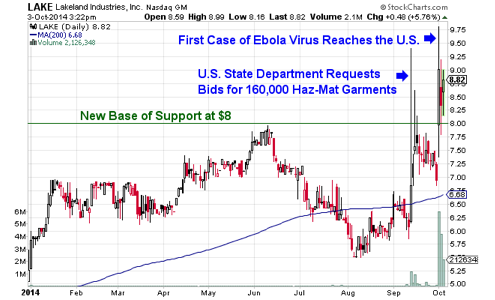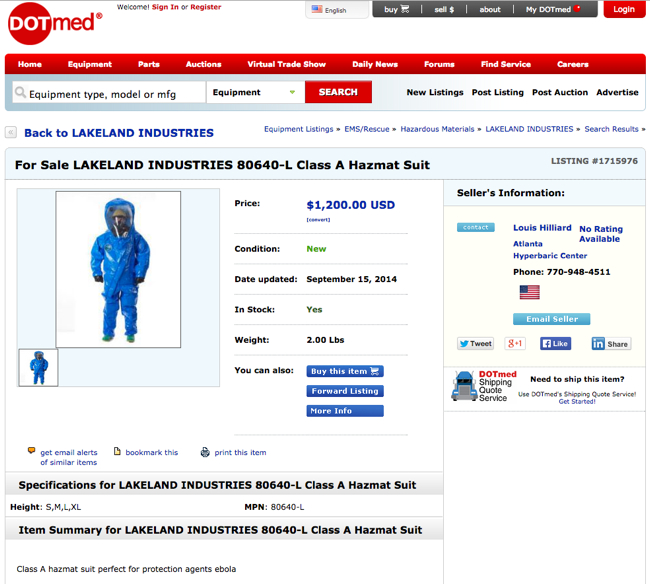New York (JasonBondPicks) — A team of researchers, led by Marcelo F. C. Gomes, Ph.D of Northeastern University, recently published a scientific paper with the Public Library of Science (PLOS) about the chances of an Ebola outbreak in the developed world. They concluded that the “outbreak is progressing at a fast pace and is considered an international health threat.
The Center for Disease Control and Prevention (CDC) stated that the Ebola virus can only be transmitted by way of body fluids, and released an infographic, Facts about Ebola, wherein the graphic listed three ways people cannot become infected with the deadly virus, including through contaminated food, water or air.
However, how the virus spreads under different conditions has become a concern now that the first case of an Ebola infected person has reached U.S. shores this week, in Dallas, Texas.
“[T]here’s all the difference in the world between the U.S. and parts of Africa where Ebola is spreading,” stated the CDC in a news release of Sept. 30. “While it is not impossible that there could be additional cases associated with this patient in the coming weeks, I have no doubt that we will contain this.”
However, the Dallas case is the first case to be diagnosed outside Africa, with implications of a more-rapid transmission of the disease in cooler climes frightening those with a better handle of the particular details of the possibilities of the deadly virus spreading more easily and rapidly in the higher latitudes of North America.
According to the US Army’s Center for Aerobiological Sciences, Medical Research Institute of Infectious Diseases at Fort Detrick, Maryland:
(1) Ebola has an aerosol stability that is comparable to Influenza-A
(2) Much like Flu, Airborne Ebola transmissions need Winter type conditions to maximize Aerosol infection
Filoviruses, which are classified as Category A Bioterrorism Agents by the Centers for Disease Control and Prevention (Atlanta, GA), have stability in aerosol form comparable to other lipid containing viruses such as influenza A virus, a low infectious dose by the aerosol route (less than 10 PFU) in NHPs, and case fatality rates as high as ~90% .
The mode of acquisition of viral infection in index cases is usually unknown. Secondary transmission of filovirus infection is typically thought to occur by direct contact with infected persons or infected blood or tissues. There is no strong evidence of secondary transmission by the aerosol route in African filovirus outbreaks. However, aerosol transmission is thought to be possible and may occur in conditions of lower temperature and humidity which may not have been factors in outbreaks in warmer climates. At the very least, the potential exists for aerosol transmission, given that virus is detected in bodily secretions, the pulmonary alveolar interstitial cells, and within lung spaces. [emphasis added]
In other words, the Ebola virus possibly can be transmitted through air if the air temperature and humidity are lower than the tropical climes of West Africa. But, if the Ebola virus becomes transmittable through air, how can the CDC be so confident that the virus will be contained? Which brings to mind a comment made by the then-Prime Minister of Luxemburg, Jean-Claude Juncker, during the height of the financial crisis in May 2011, “When it becomes serious, you have to lie.”
With North America approaching the winter season, the following months will shed more light on whether the CDC is accurate, or dangerously incorrect (or lying) about its assumptions.
One person intimately familiar with the data is Anthony Banbury, the Secretary General’s Special Representative, who told The U.K. Telegraph:
We have never seen anything like it. In a career working in these kinds of situations, wars, natural disasters – I have never seen anything as serious or dangerous or high risk as this one. I’ve heard other people saying this as well, senior figures who are not being alarmist.
Behind closed doors, they are saying they have never seen anything as bad.
There is a limited window of opportunity. We need to hit it and we need to hit it hard. We haven’t done that but we are doing it now.
Banbury also told the Telegraph that, if the Ebola virus mutates and evolves into an infectious airborne strain, the scenario then becomes “a nightmare.” And he strongly suggests that, with little information now available about the virus’ various mutations, the possibility of Ebola morphing into an airborne transmitting disease “can’t be ruled out” by U.S. health officials.
Potential Scenarios for LAKE Includes a Monster Pop in Price
The share price of Lakeland Industries, Inc. (LAKE) has risen more than 50% from the 2013 closing price of $5.26, and now trades close to its Book Value. The company has been marginally unprofitable during the past few years, but its balance sheet looks reasonably healthy for a company that generates approximately $90M of revenue, a Gross Margin of 27.1%, and a steady Sales, General Administration expenses of $25M+.
The maker of hazardous clothing has come into sudden focus on Wall Street, following the Sept. 15 notification of the U.S. State Department’s request for bids to purchase 160,000 haz-mat suits in response to elevated risks of the latest Ebola outbreak reaching the United States. Nearly a million shares traded hands that day, up hundredfold from a typical day’s trading activity of only approximately 10,000 shares.
On the 15th, after opening at $6.18, LAKE soared to as high as $9.40 before closing at $6.85.
On Oct. 1, nearly six million shares of LAKE traded hands, following reports of a hospital admission in Dallas, TX of a man being treated for Ebola virus, the first case of an infected person exhibiting symptoms on American soil. LAKE again soared, reaching as high as $9.80 before closing at $9.01, a price level not seen since Jan. 2012.
Lakeland generates more than 90% of its revenue from the manufacture and sale of haz-mat clothing, with reported sales for fiscal year ending Jan. 2014 of $91.4M and a near-breakeven bottom line.
The 160,000 haz-mat order by the U.S. State Department equates to between than $140M and $160M of revenue to the successful bidder.
Though the Lakeland management has not issued a news release which addresses whether the company has submitted a bid to the U.S. State Department, or not, we suspect a new release will be forthcoming soon about the subject.
In the fortuitous event of Lakeland receiving an order of as much as 160,000 haz-mat garments, we calculate that revenue could more than double and net income (after taxes) could reach as high as $17M, or $3.29 per share for fiscal 2015. Using the S&P 500 present Price-to-Earning ratio of 19.5, a valuation of one LAKE share calculates to $61.15, though it is unknown if orders would tail off, or possibly accelerate from more export orders to satisfy sudden demand against the backdrop of a limited global supply.
Given Lakeland’s tiny 5.38M shares outstanding, even a small portion (say, 13,240 garments) of an awarded contract would only have to generate an additional $13.24M of revenue, or an estimated $0.44 cents per share net profit, to warrant a $8.50 price for LAKE.
The coming months will dictate further trader interest in the stock. If the number of Ebola cases increase in North America, especially during the cold winter months, public panic and a public response could result, taking LAKE to unpredictable price levels for rational, or irrational reasons.
Looking for real time trade alerts on stocks like LAKE?
To get insightful analysis on stocks in-the-news BEFORE the big move, start by joining our mailing list (top of the page). Or, take the next bold step now by joining Jason’s community of dynamic and active traders with your subscription to Jason Bond Picks.
Disclosure: I am long LAKE



good article. i see just 1 issue with it: the 9/12 p/r by lakeland references the Chemmax 1 suit only. And the chemmax 1 does not appear to me to be the same as this suit: http://www.lakeland.com/europe/our-products/chemical-protective-clothing/chemmax-1.html.
Also, this distributor has it for a lower price: http://www.nationalsafetyinc.com/ChemMax-1-Chemical-Protective-Suit-P735657.aspx